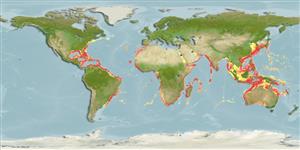Actinopterygii (ray-finned fishes) >
Perciformes (Perch-likes) >
Rachycentridae (Cobia)
Etymology: Rachycentron: Greek, rhachis, -ios = spine + Greek, kentron = sting (Ref. 45335).
Environment / Climate / Range
Ecology
Marine; brackish; reef-associated; oceanodromous (Ref. 51243); depth range 0 - 1200 m (Ref. 9739). Subtropical; 17°C - 32°C (Ref. 12459), preferred 27°C (Ref. 107945); 47°N - 37°S, 98°W - 166°E (Ref. 12459)
Worldwide in tropical and subtropical waters, but absent in the eastern Pacific (Ref. 9739, 33390) and the Pacific Plate, except marginally (Ref. 10948). Western Atlantic: Canada (Ref. 5951) to Bermuda and Massachusetts, USA to Argentina (Ref. 7251), including the Gulf of Mexico (Ref. 9626) and entire Caribbean (Ref. 26938). Eastern Atlantic: Morocco to South Africa. Indo-West Pacific: East Africa (Ref. 2871, 5213, 6644, 30573) and Hokkaido, Japan to Australia.
Length at first maturity / Size / Weight / Age
Maturity: Lm ?, range 43 - ? cm
Max length : 200 cm TL male/unsexed; (Ref. 10790); common length : 110 cm TL male/unsexed; (Ref. 3487); max. published weight: 68.0 kg (Ref. 7251); max. reported age: 15 years (Ref. 9739)
Dorsal
spines
(total): 7 - 9;
Dorsal
soft rays
(total): 26-33;
Anal
spines: 2-3;
Anal
soft rays: 22 - 28. Head broad and depressed. First dorsal fin with short but strong isolated spines, not connected by a membrane. Caudal fin lunate in adults, upper lobe longer than lower. Back and sides dark brown, with 2 sharply defined narrow silvery bands.
Adults occur in a variety of habitats, over mud, sand and gravel bottoms; over coral reefs, off rocky shores (Ref. 10948) and in mangrove sloughs; inshore around pilings and buoys, and offshore around drifting and stationary objects; occasionally in estuaries (Ref. 9739). Form small groups and may pursue small pelagic inshore (Ref. 48635). Feed on crabs, fishes, and squids (Ref. 5213, 10948, 13442). Form spawning aggregations during the warm months in the western Atlantic; eggs and larvae planktonic (Ref. 12459). Caught in small quantities due to its solitary behavior (Ref. 9626). Good food fish; marketed fresh (Ref. 5284), smoked, and frozen (Ref. 9987). Also caught for sport (Ref. 26938).
Form spawning aggregations during the warm months in the western Atlantic; eggs and larvae planktonic (Ref. 12459).
Shaffer, R.V. and E.L. Nakamura, 1989. Synopsis of biological data on the cobia Rachycentron canadum (Pisces: Rachycentridae). NOAA Tech. Rep. NMFS 82, FAO Fisheries Synopsis 153. (Ref. 9739)
IUCN Red List Status (Ref. 115185)
CITES (Ref. 94142)
Not Evaluated
Threat to humans
Harmless
Human uses
Fisheries: minor commercial; aquaculture: commercial; gamefish: yes
Tools
Special reports
Download XML
Internet sources
